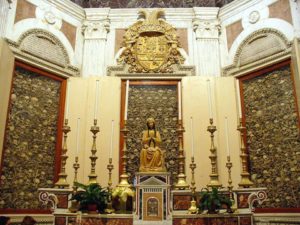General Magyar Balázs saves Otranto in 1481
The Ottoman Empire was based on constant conquest like many empires. After taking Byzantium in 1453, the Ottomans cast their eyes on the “Golden Apples” such as Buda, Vienna, and Rome. At first, they attacked their greatest rivals, the Hungarian Kingdom. However, they suffered a staggering defeat in 1456 at Nándorfehérvár aka Belgrade by Hunyadi János and Johannes de Capistrano. You can read about it more here:
https://www.hungarianottomanwars.com/1372-1490/why-can-we-hear-the-bells-at-noon-1456/

Later, they tried to attack Transylvania but again, they were beaten. The defeat at Breadfield (Kenyérmező) in 1479 made the Ottomans understand that they had to attack Western Europe from a different angle. Read more about this battle here:
https://www.hungarianottomanwars.com/1372-1490/the-battle-of-breadfield-kenyermezo-1479/N
ext year, they launched an attack on Italy and they seemed to be successful in the first 13 months.
The Ottomans attacked Italy in 1480
It was King Matthias Corvinus who saved Italy by defeating them at Otranto. I wonder what would have happened if he had not sent their troops? Would the Ottoman Empire have launched its future campaigns against Europe through Italy instead of through Hungary? It remains to be answered forever.

Count Zrínyi Miklós aka Nikola Zrínski (1620-1664) wrote about this war in his book about King Matthias like this:
“Also, the king has sent help to his father-in-law against the Turks; he sent there Magyar Balázs with 2,000 Hungarians to Neopolis who quickly stroke Hidruntum out from the hands of the Turks.”
Indeed, the Turks made a very dangerous threat against the mainland of Christendom by seizing a bridgehead in Italy.
In 1480, Sultan Mehmet the Conqueror sent an Ottoman fleet with 20,000 soldiers to invade Rome under the command of Gedik Ahmed Pasha. This force reached the shores of Apulia on 28 July 1480 and the city was captured in two weeks on 11 August 1480. The arriving Turks slew about 12,000 people.

There was a huge panic all over in Italy, the Pope was planning to flee from Rome.
Meanwhile, in Otranto, some 800 citizens, known as the “Martyrs of Otranto,” were taken to the Hill of Minerva and they were all beheaded after refusing to convert to Islam. They were canonized by Pope Francis on 12 May 2013. You can see their skulls in the church on display.

Between August and September 1480, the Italian and European kingdoms failed to help King Ferdinand of Naples, except his cousin Ferdinand the Catholic, the Kingdom of Sicily, and, later, the Republic of Genoa.
In 1481, the Pope, in panic, called for a crusade to be led by King Ferdinand of Naples, brother-in-law of King Matthias Corvinus. He asked him for help so Matthias sent troops. As for Otranto, the Turks controlled the city for 13 months. The Hungarian king sent 2,100 soldiers led by his General Magyar Balázs who successfully captured Otranto.

It was how he did it: the town’s water supply was fed by a source outside which was fortified and well guarded by the Turks. General Magyar took it by a hard fight and the rest of the Turk army had no more water. His relatively small army was able to repel the desperate Turk attacks. Finally, the Turks had to surrender and leave the place on their boats.
Mehmet II died on his way to capture the rest of Italy. His successor, Bayezid II, ordered Gedik Ahmed Pasha to be hanged, and on 11 September 1481, the Turks abandoned the city which had never been able to recover from this disaster.

One wonders what would have been the fate waiting for the rest of Italy if the Hungarians hadn’t taken Otranto back.
General Magyar Balázs

As for Magyar Balázs (remember, I use the names intentionally the way Hungarians use them, placing the given name after the family name), he was a famous military commander and great officer, his military career started under the command of Hunyadi János. Allegedly, he had come from a peasant family from the area of Méra, near Kolozsvár (Cluj, Klausenburg). He was appointed as the Captain of the Felvidék (Upper Lands, the northern part of the Hungarian Kingdom) in 1462.

During the reign of King Matthias, he was Ban (Duke) of Croatia from 1470 to 1472 and in 1483, Ban of Slavonia between 1470 and 1471 and in 1483, Ban of Bosnia from 1470 to 1471, and Voivode of Transylvania between 1472 and 1475. He was supporting the Voivode of Moldova with his troops. However, he could not defend the Island of Veglia against the Venetians in 1479. His campaign to Otranto took place in 1481 as we have said. He was awarded lands in Trencsény and the Trans-Danubian Region. His daughter, Begina became the wife of General Kinizsi Pál and they lived in Nagyvázsony Castle.
More about Kinizsi Pál:
https://www.hungarianottomanwars.com/essays/kinizsi-pal-general-of-king-matthias/
Magyar Balázs died at Kassa (now Košice, Kaschau in Slovakia) in 1490.
Zrínyi concludes in 1657: “Now, the whole world can see that the illness of the Hungarians is not just their own but it is common because the Turks might assault Vienna or Venice whenever they want to, they can attack these countries when they would like to. Cyprus has gone, Candia is dying; Sicily, what will you say to this, perhaps you would not have a share in this fire? You had better not laugh, Italy…”
The Pope issued a minted medal in remembering the martyrs of Otranto, 400 years after the famous battle and he was talking warmly about the Hungarian liberators of Otranto. In the picture, you can see this coin:

Dear Readers, I can only make this content available through small donations or by selling my books or T-shirts.
If you like my writings, please feel free to support me with a coffee here:
You can check out my books on Amazon or Draft2Digital, they are available in hardcover, paperback, or ebook:
https://www.amazon.com/dp/198020490X
or at https://books2read.com/b/boYd81


My work can also be followed and supported on Patreon: Become a Patron!http://Become a Patron!



